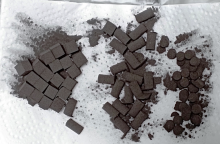Rec4AM - Increasing raw material efficiency by utilising residual material streams from die-sinking EDM for additive manufacturing processes
In order to produce high quality products using additive manufacturing, it is necessary to use high quality raw materials, which due to the costly atomization process are very expensive. Such powders have a very homogeneous chemical composition, high sphericity and rather small size distribution.
Particles with rather similar geometrical characteristics as by-product, i.e., waste, are also produced during the widely used sink erosion process. These particles together with the dielectric fluid, mostly mineral oil derivatives, are disposed as erosion-waste, which is very cost-intensive as well.
In project Rec4AM, this erosion-waste will be processed in order to separate the metal powders from the dielectric fluid and prepare them for additive manufacturing (AM) process. The metal powders will be purified, dried, sieved and sorted so that they could be used in such AM processes as LBM, EBM, DMD and their quality would be comparable to that of primary product, i.e., AM powder produced by means of atomisation. A series of mechanical tests will be carried out in order to directly compare the quality of the parts produced from the recycled powders and from the commercially available ones. In this way, it should be possible to upscale the metal particles from erosion-waste and promote them as ecological and economical resources in the growing field of additive manufacturing.
Project partners
Institute of Mechanical Process Engineering and Mineral Processing
TU Bergakademie Freiberg
Beckmann Institute for Technology Development
Project duration
01.03.2021 - 31.12.2024
Main contact
Prof. Dr.-Ing. Henning Zeidler
+49 3731 39 3066
additive_fertigung [at] imkf [dot] tu-freiberg [dot] de
Research team
Prof. Dr.-Ing. Henning Zeidler
Dipl.-Ing. Toni Böttger
Dr.-Ing. Stefan Krinke
Dipl.-Ing. Martin Krinke
Work package 1 - Acquisition of knowledge and skills for technical progress in metal AM
The work package covers broader knowledge and skills required to master the process chains of metal AM manufacturing and post-processing and will provide background knowledge for the implementation of the exploratory research project (WP2). The objectives are:
- Master the metal AM process chains
- Co-supervise a PhD student in the field of powder blending, LMD and characterisation
- Co-supervise a PhD student in the field of LMD and post-processing.
Work package 2 - Explorative research project
The overall objective of the project is to define the process chain for the production of components made of FGMs, i.e. the definition of LMD and PeP process parameters for the production of structures made of high-performance materials (maraging tool steel) on cast iron. This is to be achieved by:
- production of powder mixtures for the build-up of high-quality layers of maraging tool steel on cast iron
- determination of process parameters for the production of LMD
- determination of process parameters and the electrolyte composition for post-processing by PeP
- metallurgical and mechanical characterisation of the demonstrators produced.
Work package 3 - Training as a motor for top performance
The overarching goals of WP4 are to increase UL's research excellence and innovation capacity in AM and to improve AM education that is aligned with industry needs at the highest academic level, with a focus on material blending, LMD processes and PeP post-processing. This will be achieved by:
- Technical knowledge transfer through virtual training, on-site training, staff exchange, expert visits, joint summer schools
- Non-technical knowledge transfer through pre-defined and ad hoc virtual sessions, on-site training including job shadowing with a focus on research management including technology transfer and IPR, and project management including financial reporting.
Work package 4 - Dissemination, utilisation and communication
One way to ensure the long-term benefits of SEAMAC is to increase collaboration with industry. It is expected that the results of increased research excellence and expanded communication activities will generate commercial interest from industry, enabling sustainable growth of the AM field after the end of the project:
- Knowledge management and protection while realising the ERA priorities of optimal dissemination, access and transfer of scientific knowledge
- Strengthening links with existing and potential AM users through industry-focused workshops and collaboration agreements
- Building a strong communication and collaboration network
- Raising awareness among key stakeholders, including the research and academic community, target industries, policy makers/regulators, primary and secondary schools and the general public
- Awareness of the project.
Work package 5 - Project management/coordination
This work package will ensure timely, effective and successful implementation of the project through a high level of administrative, contractual, financial and managerial support. The main objectives are:
- Ensure deliverables and milestones are met and the project stays on time and within budget
- Lead the reporting of results and ensure close collaboration; - Participate in the assessment of progress of each working group
- Organise and lead project meetings; - Participate in resolving conflicts, managing risks and taking necessary corrective actions (with the support of the coordinator and supervisor as appropriate). with the support of the Coordinator and the Monitoring Committee as appropriate)
- Manage the project's relationship with the European Commission by ensuring that all required documentation is produced on time and to the highest standard.


